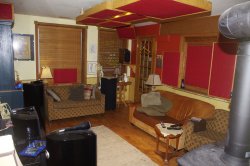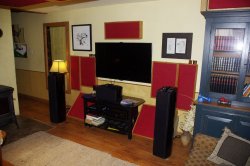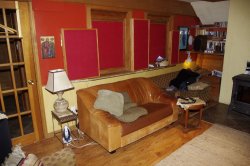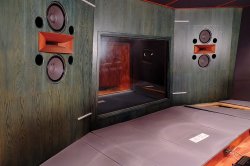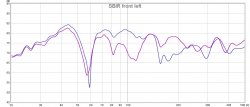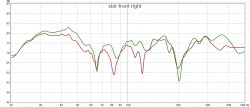Hi,
great discussion here about treatment, Rt60, first reflexion and live or room. Is it too mutch to ask to get any comments on my measurements related to those subjects.
All measurements are no EQ, speakers to large. Treatments are DIY panels fill with Roxul AFB 3 inches. Ceiling panels are 4 inches gap.
I do not think that I could do more to help but maybe you could suggest something. Please note that for waf reasons, a second sub is a death sentence for yours truly!
My room:15'4" x 11' 6" x 7'6" tv at the center of the long side wall
Thanks FargateOne, you absolutely can ask for a review. We like that part of this work! I've moved your question to its own thread so that we don't hijack the other.
First, looking just at the response, and focusing mostly on the bass, it looks like you have some dips in the bass related to the speakers placement. That dip at 55hz appears to be caused by the position of the main speakers and shows up in both the combined response and individual speaker response. Depending on how the sub and mains are operating, this might be fixable. If the mains operate as full range, ideally you want the sub to also operate over the same range up to 80-100hz. This should help fill in that gap (but not always). Another option is to pull the speakers out into the room, as its an SBIR effect.
The trough from 90hz to 120hz is a result of multiple factors from what I can tell. It appears to be both SBIR effects from each of the speakers placement (including the sub) and the room's modes. Namely there seems to be modes causing peaks on each side, but nothing right where the trough is. Mix that with some SBIR effects and you have a perfect storm for a big trough.
When I have this problem the first thing I do (since its easiest) is to try flipping the phase on the sub and see if its any better. If not, then I switch it back and adjust the delay to the sub. Is it better (in 1 foot increments)? I generally find the delay offers little benefit but sometimes it can narrow these troughs. The polarity flip sometimes does a lot and sometimes doesn't. They are good first efforts because you don't need to move anything. I also play with the crossover, but to be honest, I find this makes little difference with troughs or dips.
Of course SBIR effects can only be fixed by moving the sources. Your mains are just in a bad position relative to the front wall to cause SBIR in a bad area. The only fixes are a) pull the speakers out a few feet (and I get that probably isn't feasible), and b) push them back closer to the wall (and I get that may not be feasible either).
Other options are to absorb the LF's that are causing the interference. This is easier said than done because we are talking about LF's around 50-60hz and 90-120hz, which all are below the range where typical velocity absorbers are very effective. These actually need to be placed directly where reflection is happening too, so behind the speakers and behind you (front and rear walls). Floor and ceiling bounce can also cause this and may also be contributing to the width. Your ceiling seems well treated, but the ceiling treatment may not be absorbing low enough. The floor bounce is untreated as the carpet is just too thin. You could try placing large pillows on the floor to see if that changes the measurement.
Your RT60 is flat, low, and relatively smooth. No issues there.
Your Waterfall (CSD) looks minimum phase. The peaks and troughs match the peaks and troughs in the frequency response plot. Smoothing the bass further would smooth it, but it isn't bad either.
The ETC plot seems to show a little bit of diffraction effects, but I have no idea whats causing them. You may want to try pulling the speakers out another foot and remeasure just to see.
The Center channel measurements look mostly good. I would consider placing the center on some foam or a separate stand to see if that improves anything. It doesn't look all that bad, but placing a speaker on a wide and deep stand causes diffraction and can impact voice clarity. I prefer to avoid that. An idea scenario would be to get rid of that rack and have the center be on an actual speaker stand. Then move the equipment somewhere else.
The surround speakers are very near the rear wall. because of how they are aimed they will have reflections off this wall and that can call attention to the speaker. Your surround speakers show reflections at around 2 feet or so. I suspect it could be the rear wall. Putting an absorber or scattering surface on the wall near the speaker could help improve things. It isn't bad now, just a suggestion. The reflection only appears to be 3-5 db's below the direct signal.
You have a number of panels that appear to be placed in areas that wouldn't help with mid or high reflections, but because they are veolicty absorbers, that is their primary advantage. As such, you might consider adding a membrane to the front of those panels to reduce their mid and high frequency absorption, but increase the bass absorption. I often suggest carpet protection film or a painters drop cloth (the plastic type).
The polar response of the B&W speakers you have shows the smoothest response to be on axis and less so off axis. Your speakers don't appear to be toed in much. I suggest toing them so they point at your head. See how that sounds. Also try a little less or a little more. There is an inexpensive iPhone app for toeing speakers you can try if you want repeatable results called SpeakerAngle. It might be available on Android, I'm not sure.







